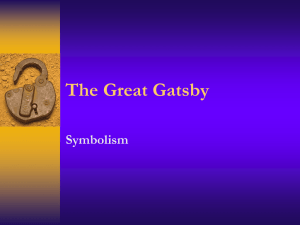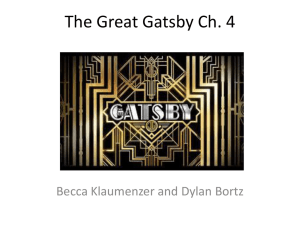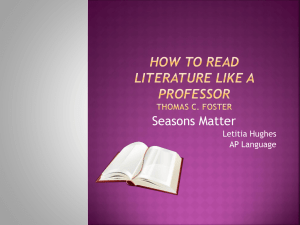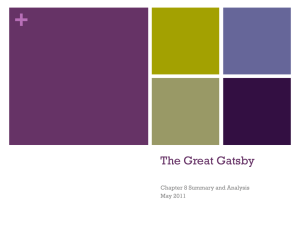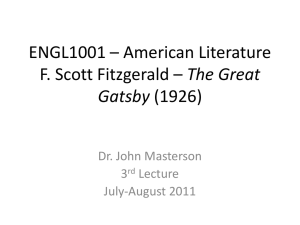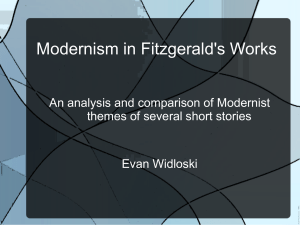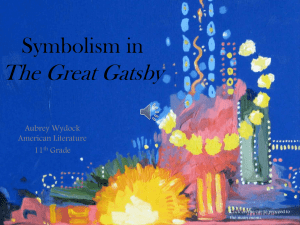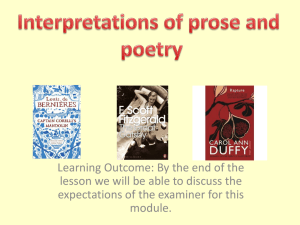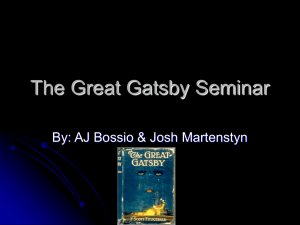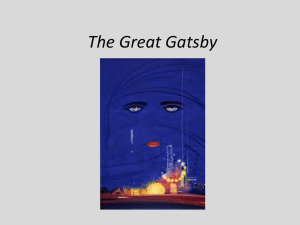The Great Gatsby
advertisement
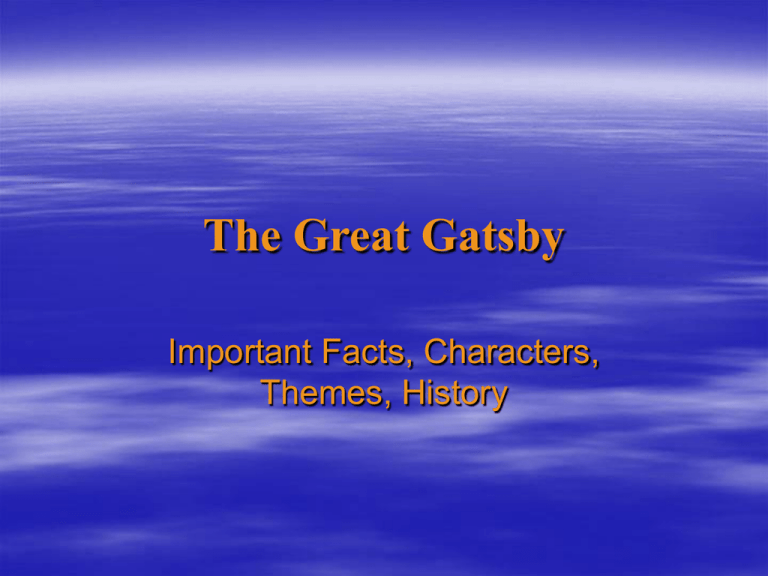
The Great Gatsby Important Facts, Characters, Themes, History Modernism 1914-1946 The Modernist literary genre consisted of: – Highly experimental writing – Allusions in writing often referring to classical Greek and Roman texts – Usage of fragments, juxtaposition, interior monologue, and stream of consciousness – Writers were seeking to create a unique style Modernist content: Dominant mood = alienation and disconnection - people unable to communicate effectively - fear of eroding traditions - grief over loss of the past Content con’t. – The individual belongs to a ‘lost generation” – The individual suffers form a “dissociation of sensibility” – The individual has a “Dream Deferred” The Result/Effect = Common readers are alienated by this type of literature Historical context – Overwhelming technological changes of the 20th century – W.W.I was the first war of mass destruction due to technological advances – Rise of youth culture Literary Achievements: – Dramatization of the plight of women – Creation of literature of the urban experience – Continuation of the pastoral or rural spirit – Continuation of regionalism and local color Modern Themes – The impact of the 1918 Bolshevik Revolution in Russia – The Jazz Age – The passage of the 19th Amendment – Prohibition of the production, sale, and consumption of alcoholic beverages, 1920-1933 – Impact of the stock-market crash and Great Depression of the 1930’s Important Facts Genre – modernist novel, Jazz Age novel, novel of manners Time and place written – 1923-1924, America and France Narrator – Nick Carraway, he not only narrates but implies that he is the book’s author Point of View – Nick Carraway narrates the book both in first and third person He presents only what he himself observes Nick alternates sections where he presents events objectively, as they appeared to him at the time, with sections where he gives his own interpretations of the story’s meaning and of the motivations of the other characters Tone – Nick’s attitude toward Gatsby and Gatsby’s story are ambivalent and contradictory – At times he seems to disapprove of Gatsby’s excesses and breaches of manners and ethics – He also romanticizes and admires Gatsby, describing the events of the novel in a nostalgic and elegiac tone Characters Nick Carraway – After being educated at Yale (New Haven) and fighting in W.W. I (The Great War) Nick goes to New York City to learn the bond business – After moving to West Egg, a fictional area of Long Island that is home to the newly rich, nick quickly befriends his next-door neighbor, Jay Gatsby – As Daisy Buchannan’s cousin, he rekindles the romance between she and Gatsby Jay Gatsby – The title character and protagonist, Gatsby is a wealthy young man living in a Gothic mansion in West Egg – He is famous for the lavish parties he throws every Saturday night, but no one knows where he comes from, what he does, or how he made his fortune – Nick learns Gatsby made his fortune through criminal activity, as he was willing to do anything to gain the social position to win Daisy Daisy Buchannan – Nick’s cousin, and the woman Gatsby loves – She previously fell in love with Gatsby and promised to wait for him – However, she harbors a deep need to be loved, and decides not to wait for Gatsby when wealthy Tom Buchannan asks her to marry him – She now live across from Gatsby in the fashionable East Egg district of Long Island – She behaves superficially to mask her pain at her husband’s constant infidelity Tom Buchannan – Powerfully built, he is from a socially solid old family and is arrogant, hypocritical, and a bully – His social attitudes are laced with racism and sexism, and he never considers trying to live up to the moral standard he demands from those around him – He also has no qualms about his extramarital affair with Myrtle, but suspects Gatsby and Daisy of having an affair Jordan Baker – Daisy’s friend and who Nick becomes romantically involved with Myrtle Wilson – Tom’s lover, whose lifeless husband George owns a run-down garage in the Valley of Ashes – She is always looking for a way to improve her situation and unfortunately chooses Tom, who treats her like an object of his desire George Wilson – Myrtle’s husband, the lifeless, exhausted owner of a run-down auto shop at the edge of the Valley of Ashes – He loves and idealizes myrtle, and is devastated by her affair with Tom – He is comparable to Gatsby in that they are both dreamers and both are ruined by their unrequited love for women who love Tom Owl Eyes – The eccentric drunk whom nick meets at the first party he attends at Gatsby’s mansion Klipspringer – The shallow freeloader who seems almost to live at Gatsby’s mansion, taking advantage of his host’s money Themes The Decline of the American Dream in the 1920’s – The main theme of the novel takes place over the course of a few months during the summer of 1922 It is set in a circumscribed geographical area in the vicinity of long Island, New York – The novel is a symbolic meditation on 1920’s America as a whole in particular the disintegration of the American dream in an are of unprecedented prosperity and material excess – Fitzgerald portrays the 1920s as an era of decayed social and moral values, evidenced in cynicism, greed, and empty pursuit of pleasure – The reckless decadent parties and wild jazz music, epitomized in the novel, resulted ultimately in the corruption of the American Dream, as the unrestrained desire for money and pleasure surpassed more noble goals The rise of the stock market after WWI led to a sudden, sustained increase in the national wealth and a newfound materialism, as people began to spend and consume at unprecedented levels As well, the passage of the 18th Amendment created a thriving underworld designed to satisfy the massive demand for bootleg liquor There is a clash between new and old money as symbolized in the geography of the novel – East Egg represents the established aristocracy – West Egg consists of the self-made rich – Gatsby’s fortune relates to that of organized crime and bootlegging The American dream was originally about discovery, individualism, and the pursuit of happiness In the 1920’s depicted in the novel, easy money and relaxed social values have corrupted this dream, especially on the East Coast The Hollowness of the upper Class Fitzgerald portrays the newly rich as being vulgar, gaudy, ostentatious, and lacking in social graces and taste In contrast, the old aristocracy possesses grace, taste, subtlety, and elegance PLOT Tense – past Setting – summer, 1922 on Long Island and in New York City Protagonist – Gatsby and/or Nick Major Conflict – Gatsby has amassed a vast fortune in order to win the affections of the upper-class Daisy Buchannan, but his mysterious past stands in the way of his being accepted by her Foreshadowing – The car wreck after Gatsby’s party in chapter III Rising Action – Gatsby’s lavish parties, Gatsby’s arrangement of a meeting with Daisy at Nick’s Climax – Two possibilities: Gatsby’s reunion with Daisy, the confrontation between Gatsby and Tom in the Plaza Hotel
